PinotFile: 6.37 August 24, 2007
|
When I’m Sixty-FourSixty-four is not a major age milestone, but I will take it anyway. Paul McCartney memorialized aging in his love song, “When I’m Sixty-Four,” written at the tender age of 16. I gathered up a few wine cronies, most of whom are hovering around my same age, raided my cellar for some good Burgs and sat down on a Sunday afternoon to celebrate another year. The well-cellared wines turned out to be vinous treasures resulting in a very memorable tasting. Here is the lineup with some commentary. All wines had appropriate fills and there were no corkage issues. 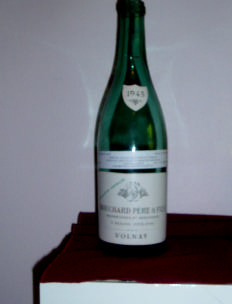 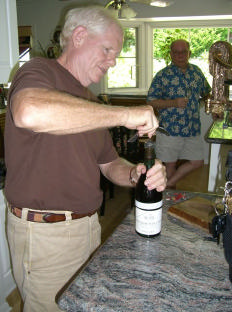
2002 Domaine Drouhin Chambolle Musigny Les Amoureuses 1er 13.0% alc.. This vineyard is one of a handful that many experts deem worth of grand cru status (and is priced accordingly). It is situated just below Musigny and is considered the “younger brother to Musigny.” · The aromatics are quite sensual featuring violets, roses, and cassis. The predominately red fruit flavors are buttressed by brisk acidity. Clean, crisp and thoroughly satisfying, this is truly a complete wine deserving of great admiration.
2000 Domaine Comte Georges de Vogue Chambolle Musigny 1er Cru 14.0% alc.. The Domaine produces about 4,000 cases a year of five wines: Musigny Blanc, Chambolle Musigny, Chambolle Musigny 1er Cru, Chambolle Musigny Les Amoureuses 1er Cru, Bonnes-Mares, and Musigny. The Chambolle Musigny 1er contains grapes from young Musigny vines. · The striking aromatics come at you like a speeding truck and are far and away the most flamboyant in the lineup save the La Tache. Cinnamon spice, ripe dark cherry and some buttery oak aromas lead to a fat and rich stuffing of mature red and black fruits. There is some earthiness as well. The texture is all silk. Seduction 101.
1999 Domaine Romanee-Conti Le Tache 11-14% alc., $450. Le Tache is a legendary wine of such great acclaim that it is hard to do it justice by any descriptive measure (it is said that you discuss a good Bordeaux, but you simply enjoy a good Burgundy). It is also hard to see beyond the label. La Tache is, of course, a monopole, like Romanee-Conti. · There is bottomless cassis, wild strawberries and Oriental spice on the nose with dark cherries flashing through the flavors. Rich in the nose and the taste (“stacked and packed”), yet elegant and refined, it seems perfect in every way. Although a treat to drink now, it is still a youngster and withholding some hidden charms. Truly, a festive occasion.
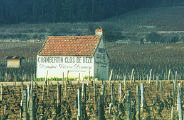 1996 Domaine Pierre Damoy Clos de Beze 13.5% alc.. Clos de Beze lies north of Chambertin, between it and Mazis. Pierre Damoy owns the largest parcel of the climat by far. · The nose is replete with hi-tone dark cherries, raspberries and baking spice. Rich and concentrated, the wine displays a copious amount of sweet, sappy fruit which carries to a lengthy and refreshing finish highlighted by a berry kiss. There is lively acidity to buttress the fruit.
1995 Haegelen-Jayer Clos Vougeot Alfred Haegelen married Madeleine, a niece of the great Henri Jayer. His wines are restrained and long-lasting. Clos Vougeot is the largest (50.59 ha) grand cru in the Côte-de-Nuits, but the quality of wines from this vineyard vary greatly due to the large number of owners and the placement of their respective blocks in the vineyard. · Quite pleasing with a charming toast note to the aromas, lively tart cherry flavors, a silky texture, and plenty of length and acidity on the thoroughly enjoyable finish.
1993 Domaine Denis Mortet Chambertain 13% alc.. Before his tragic death by suicide at the age of 49 in 2006, Mortet was a consummate perfectionist who believed in the meticulous management of his 28 acres of vineyards. His wines were bold and frequently extracted, but when he achieved more refinement, they were marvelous. I remember a number of years ago, sampling a number of mid-1990s wines from Mortet and found many heavy-handed. However, I was taken by the Les Champeaux wines and my experience with these led me to delve more deeply into Burgundy. All of his wines were made with 100% new French oak. · The aromatics were striking (dark spiced cherries, vanillin oak) and superceded the flavors. The lively acidity was wanting for a food companion. The body of fruit was on the light side, there was little grip, and the finish was short.
1991 Domaine Comte Georges de Vogue Bonnes-Mares 13.5% alc.. This Domaine can trace its roots back 550 years and today the 20th generation of the family is in charge. About 420 cases of Bonnes-Mares are produced each year from the Domaine’s holdings which are in the Chambolle portion of the vineyard. The vines average 29 years in age. Several critics have written that the Vogue wines of the 1990s are excellent and in great vintages are truly magnificent examples of fine Burgundy. · A lovely nose of ripe cherries with floral accents. Shy flavors of sweet red cherries, spice and a hint of citrus. Appears to be fading. A good wine, but disappointing considering the pedigree.
1943 Bouchard Pere & Fils Volnay 11-14% alc.. You never open a bottle like this with high expectations, but it is nevertheless always a thrill when the wine is this old. · The black cork came out cleanly. The wine was a surprise to all. The color was medium ruby with only a trace of orange tinge at the rim. There was still notable sweet red fruits on the palate with a little spice and fecundity. The wine was delicate with cashmere tannins. It was a brief, but memorable fling. because the wine was spent an hour later.
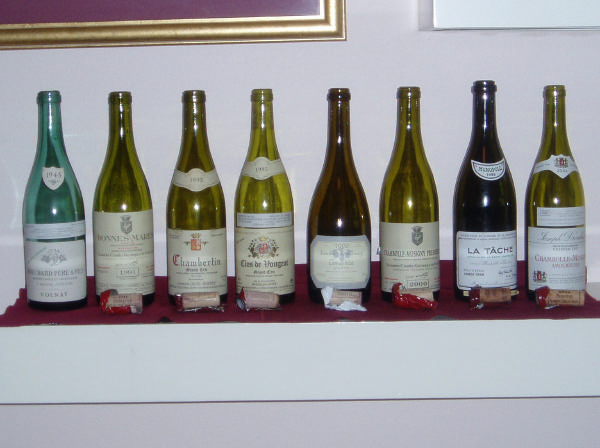 Where can you read more and learn about Burgundy? There are a number of excellent internet sources for information. Burgundy is a maze of vineyards, producers and confusing nomenclature and the Burg enthusiast must commit serious time and study to be able to purchase wisely and gain an appreciation for the myriad of wines that come from this small wine-producing region of France. A first step is to learn the geography and I have included a map of Burgundy on the next page (courtesy of Berry Bros & Rudd’s wine retailers in the UK - www.bbr.com).  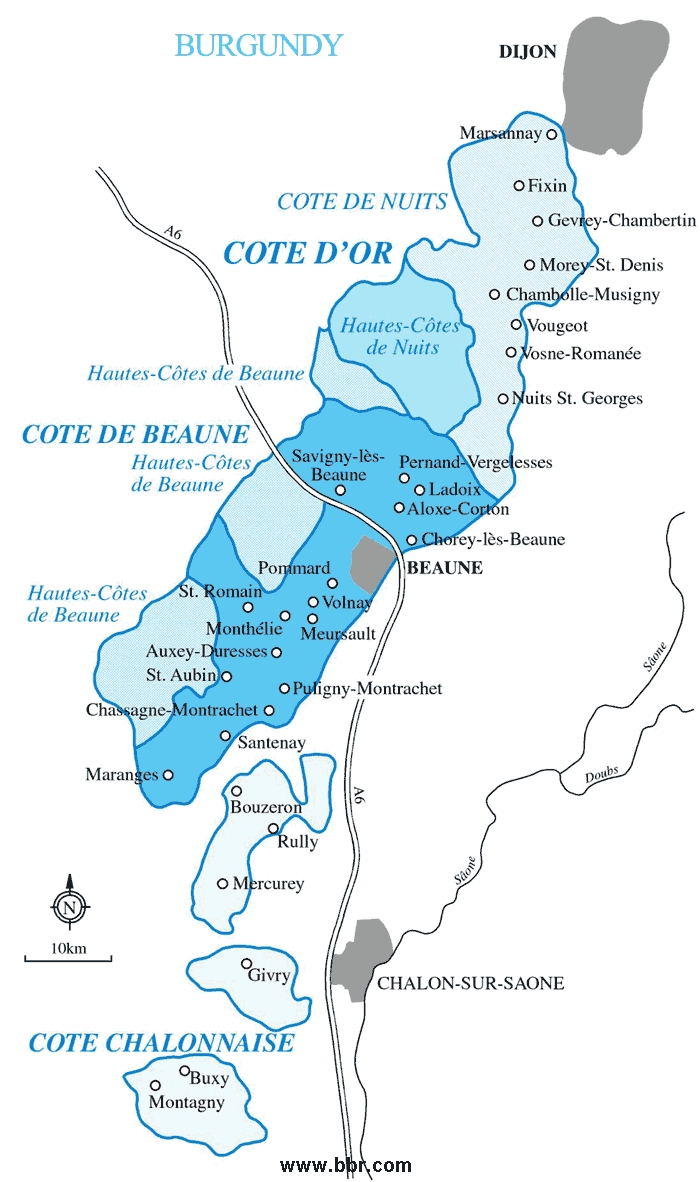 Robert Parker’s Wine Advocate (www.eRobertParker.com) and Steve Tanzer’s International Wine Cellar (www.wineaccess.com) offer primarily reviews and scores of Burgundy wines in some issues. There are several other excellent informative websites that cover Burgundy. Burgundy Report (www.burgundy-report.com) is authored by Bill Nanson who resides in Europe. He provides extensive coverage of domains with glorious photography and extensive wine reviews. Free. Elden Selections (www.eldenwine.com) is based in Burgundy and specializes in small-production, estate-bottled Burgundy wines that are little known outside France. Members of the Elden Wine ’Club’ (free) receive a twice-yearly newsletter and prospectus with up-to-date tasting notes from wine makers, winemaker profiles, access to older vintages, and a search service for those looking for a particular wine. The Burgundy Wine Institute (www.burgundywineinstitute.com) is an educational branch of the Ecole des Vins de Bourgogne in association with Elden Wine based in Beaune. The Institute offers a range of tasting-based courses to satisfy Burgundy lovers which includes walking the vineyards with the people who make the wines, “step down into the cellars, see barrels being coopered, and join in the rhythm of the wineries.” Visit the website for a sample one-week intensive program. Burgundy Briefing (www.theburgundybriefing.com) is published by Sarah Marsh M.W. from England. She is a regular contributor to Decanter magazine. Her newsletters are sold individually and cover en primeur tastings, grower profiles, tasting reviews, and Burgundy travel tips. A number of retailers specialize in Burgundy and provide considerable instructional information and credible recommendations. These include The Burgundy Wine Company in New York City (www.burgundywinecompany.com), North Berkeley Wine in Berkeley, California (www.northberkeleyimports.com) and Kermit Lynch Wine Merchant also in Berkeley (www.kermitlynch.com). Many fine wine retail stores have trained personnel who can guide you through the Burgundy maze. A knowledgeable retailer is worth his weight in wine. Several United States importers hand-pick the Burgundies they bring into this country and their name on a bottle is a guarantee of quality: Neal Rosenthal, Louis-Dressner, Robert Chadderton Selections, Polaner Selections, Robert Karcher Selections, Becky Wasserman, and Martine’s Wines. And finally, if all else fails, you can turn to Canadian Mike Mandel, whose non de plume is Deacon Dr. Fresh and he claims to be the “working man’s oenophile (www.deaconwinelist.blogspot.com). Using colorful vocabulary and proclaiming himself “The Buccaneer of Burgundy” and “The Prince of Pinot Noir,” among other outlandish titles, he says that “I have arrived to rescue the wine world from overlyserious, rigid, deconstructionist, rooster juice peckerwoods who’d never dream of getting’ a tattoo or crackin’ a smile.” Maybe he has the best approach to Burgundy - find a good producer, buy some good stuff, and forget whether the vineyard is a grand cru, a premier cru or in the alley behind someone’s cottage. Take pleasure in the wine and enjoy it for what it is. Even better, let someone else buy the Burgundy and then you can really savor it.
No Wine Before It’s Time at Kalin CellarsMicrobiologists Dr. Terry Leighton and his wife Dr. Frances Leighton founded Kalin Cellars in Marin County in 1977. Terry was the original winemaker at Domaine Laurier in the 1970s prior to starting his own label. The first wines, a Zinfandel and Cabernet, were released in 1978. Over the ensuing years, the Leightons have labored in relative obscurity producing some of the greatest California wines that only wine critics and wine geeks can testify to. The eccentric couple avoid publicity at all cost. I have been enamored with their wines for years because of their unique character, age ability and individuality. The name Kalin (KAY-len) is a local Indian word for ocean and the Leightons chose this name “because it was the only Indian word we could pronounce.” The mantra behind this winery is the use of traditional, hands-on, labor-intensive methods that do little or nothing to disturb the character of the wine -“Produce no wine with less character than yourself.” The winery itself is an undistinguished warehouse situated among other small businesses in Novato, California. Winemaking combines the Leightons’ modern knowledge of the science of vinification and traditional European methods. The Leightons like to say that the only people between you and the wine are the two of them. Baskets presses are still employed and the wines are fermented in either oak ‘cuves’ (red) or oak barrels (whites). The Leightons pioneered sur lies aged white wines in California. The have used their background as research scientists to conduct studies on yeasts and now choose yeasts that are very slow fermentors (fermentation can take eight months in barrel). The Leightons believe slow fermentation is key for the evolution of flavors in the wine, particularly the fifth taste, unami. Described as savory, pungent and meaty, unami is secondary to glutamates which are common in aged cheeses, meats and wine. The Leightons firmly believe that most wines are not capable of acquiring unami because they are made quickly and sold long before the fifth flavor is attained. The wines at Kalin Cellars are all single vintage, single vineyard wines. The Leightons own no vineyards of their own, but source grapes from distinguished vineyards outside Marin County. An exception was the use of Pinot Noir grapes from Marin County’s Devil’s Gulch Vineyard (farmed by Mark Pasternak) in 1987 and 1988. The Leightons produced sparkling rosés in those two vintages that are legendary among wine enthusiasts. The Leightons have farmed two vineyards in Burgundy, from which they make a small amount of “Kalin Bourgogne” that is sold to “Kalinites,” and restaurants. Because of the style of winemaking, the wines are not ready to drink for at least five years. Unheard of in the modern business model of wine sales, they follow no set vintage sequence. Basically, the wines are released to the market when the Leightons feel they taste good, usually between 5-10 years after the vintage. The current Pinot Noir release is the 1996 Kalin Cellars Cuvee DD Sonoma County Pinot Noir (the 1997 vintage was released last year). In essence, then, every wine that is released is a library wine! 7,000 cases of wine are produced annually usually consisting primarily of a Sonoma County Pinot Noir and Chardonnay and a Livermore Valley Semillon. Cabernet Sauvignon, sparkling wine and dessert wine have been thrown into the mix in some vintages. Most wines are designated by letters which are shorthand for identifying specific vineyard locations and signifying cuvées. Prices are quite reasonable ($40 range) considering the wines have been cellared for years prior to release. The quirky website lists currently available wines for sale (the 1996 vintage, now released, is not yet listed). To order wines, you simply call and leave a message and wait for a reply. A few select retail outlets and winesavvy restaurants offer the wines. Terry Leighton retired from his position as a distinguished microbiology professor at the University of California Berkeley in 2000. Now in his 60s, Leighton’s winemaking enthusiasm is going strong and he has the 2007 vintage fermenting in the winery. The 2005 vintage was bottled in January of this year. The Kalin Cellars Pinot Noirs are for connoisseurs only as they offer secondary bouquets and flavors that drinkers accustomed to young wines may find unpalatable. The wines offer earth, forest floor, meat, soy, and leather notes set off by plenty of racy acidity. They demand food. Last year I thoroughly enjoyed drinking the 1990, 1994 and 1995 vintages, with the 1994 my clear favorite (PinotFile, Volume 5, Issue 39).
 1996 Kalin Cellars Livermore Valley Semillon 13.8% alc., The grapes come from the Wente Estate Vineyard near Livermore planted in the 1880s from Chateau d’Yquem cuttings. 25% Sauvignon Blanc. · Hard to find a 10 year old California white wine this good. Exotic aromas of char, toast and banana. Flavors of coconut, banana, charred corn and well-toasted crème brulee. A treat to drink.
1996 Kalin Cellars Cuvée DD Sonoma Pinot Noir 13.7% alc., $38. From the Demostene Ranch in Alexander Valley, the oldest Pinot Noir vineyard in the region. · The wine has a touch of orange color on the rim. The nose opens with cigar box and mint progressing to dried cherry and dank mushrooms. Tart cherry flavors lead to very lively acidity. Many tasters will find the acidity challenging without food accompaniment.
Kalin Cellars has several vintages available in the retail marketplace: 1991, 1993, 1994, 1996, and 1997 Pinot Noir and 1996, 1997 Semillon. The website is www.kalincellars.com. 415-883-3543.
Historic School House VineyardSchool House Vineyard is located on Spring Mountain above St. Helena at the intersection of Langtry and Spring Mountain Roads. The vineyard was named after a one-room 1890s schoolhouse on the property which was destroyed by fire in the mid 1980s. The original vines, a mixed field blend, were planted in the 1890s and all of the grapes were blended into a single red table wine. Today some of the vines have been replanted to produce School House Mescolanza, a modern interpretation of the field blend. John Daniel, owner of the Inglenook Estate, gave his friend, John Q. Gantner some Pinot Noir bud wood (said to be from Domaine Romanee-Conti) and Gantner planted the Pinot Noir in his School House Vineyard in 1953. The first School House Pinot Noir was released in 1957. Chardonnay was planted in the School House Vineyard in the late 1960s, using bud wood from Fred McCrea’s Stony Hill Vineyard. The non-irrigated vineyard is located in a cool and unique microclimate at 1,500 foot elevation with well-drained soils. Currently, John M. Gantner and Nancy Walker farm the vineyard and live on the property. The School House wines are vinified at Pride Mountain Vineyards under the direction of winemaker Bob Foley and his assistant, Romel Rivera.
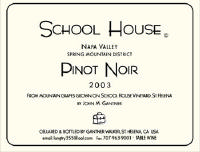 2003 School House Spring Mountain District Napa Valley Pinot Table wine, 9 barrels, $75. Label says, “From mountain grapes grown on School House Vineyard, St. Helena, by John M. Gantner. Cellared and bottled by Gantner and Walker, St. Helena.” Low yields (just under a ton per acre). Fermented in open-top bins after destemming. Aged 18 months in French oak and bottled by hand. · Deep ruby in color. A dirty diaper fragrance blows off to reveal a rich perfume of ripe cherries, Mocha java and forest floor. The concentrated flavors follow in step with added notes of cranberry, roasted plums and game. There is plenty of earthiness at heart. A touch of alcohol on the nose and finish is not intrusive. A highly distinctive wine of great character and clearly unlike a “typical” California Pinot Noir.
1993 School House Spring Mountain District Napa Valley Pinot Noir Label says, “From mountain grapes grown on School House Vineyard, St. Helena, by John M. Gantner. Cellared and bottled by Scotland Craig Partners, St. Helena.” · Mahogany color with an orange rim. Impressive aromas of dark chocolate-covered cherries with hints of toast. Tart cherry flavors with noticeable tannins lead to a finish with brisk acidity. The wine is fading and the fruit is tired and thin on the backend, but it still has some charm left.
School House Vineyard is located at 3549 Langtry Road, St. Helena. The wines are available on the website at www.schoolhousevineyard.com. Tasting by appointment (707-963-4248).
Tipsy Dog Pinot Noir - ArrrfThe Wildwood Vineyard and Winery is an 80-acre estate just east of Highway 101 on the Cuesta Grade in San Luis Obispo. Owned by the Wood family, the emphasis of the winery is on Syrah and Cabernet grown on the estate. Always on the lookout for good, reasonable Pinot Noir (almost an oxymoron), I ran across this wine at my local retailer (Pacific Ranch Market). Last summer, as part of Pinot Camp, our group had visited Wildwood Vineyard and Winery and enjoyed a fine barbeque and wines from their tasting room.
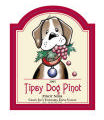 2005 Tipsy Dog Crazy Jay’s Vineyard Edna Valley Pinot Noir 14.9% alc., 500 cases, $28. Pommard clone. · A very decent Pinot Noir of medium weight. Fruit-driven aromas with plenty of dark raspberries and mocha on the palate. There is noticeable oak influence from start to finish. The alcohol is well-integrated in the prodigious fruit.
Wildwood Vineyard and Winery is located at 555 El Camino Real, San Luis Obispo. The Tipsy Dog Pinot Noir can be fetched on the website, www.wildwoodwine.com. Tasting by appointment (805-546- 1088).
Lost Canyon Winery is Consistently FineLost Canyon Winery has true gargariste origins. Started in a garage in the Montclair Hills of California in 1978, Jack States and Randy Keworth eventually teamed up with Bob Riskin and the Lost Canyon Winery was bonded in 2001. Now the urban winery is located in a renovated vintage 1900s warehouse on the San Francisco Bay waterfront south of Jack London Square in Oakland. They are one of fifteen wineries now part of the East Bay Vintner’s Alliance. The state-of-the-art winery and tasting room is contemporary and comfortable. I have been a fan since the first release in 2001. The wines have shown excellent consistency from vintage to vintage. The owners have long-term contracts with the same three Pinot Noir vineyards which contributes to the uniformity. 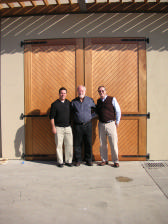  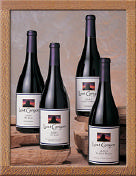 2005 Lost Canyon Dutton Ranch Morelli Vineyard Russian River Valley 14.1% alc., $40. The vineyard is located in Green Valley. Clones are 115, Pommard and Beringer. · The wine offers an aromatic charge of cherries, spice, exotic woods and floral notes. Flavors of red and black berries, tart cherries and herbs are satisfying. A hint of oak runs through from start to finish. The texture is soft and the wine is easy to drink. Similar to the Saralee’s, but more shallow and possessing less punch on the backend.
2005 Lost Canyon Los Brisas Vineyard Los Carneros Pinot Noir 14.7% alc., $40. Clones 115 and UCD 18 are used from this vineyard farmed by Francis Mahoney. · A very classy nose of ripe Bing cherry and cola. The core of cherry fruit is enhanced with oak and herbs. Great persistence and suppleness in the mouth. Good acidity carries the finish. Brilliantly crafted, you’re the one that I want.
2005 Lost Canyon Saralee’s Vineyard Russian River Valley Pinot Noir 14.0% alc., $40. Dijon clones 115 and 777. · A rich, full wine that is still light on its feet. A demure, but complex nose of cassis, raspberries, cola and bittersweet chocolate. The varietal flavors are well-presented and the tannins are well-concealed. A metrosexual wine - masculine with a feminine side.
Lost Canyon Winery is located at 2102 Dennison St., Suite A, Oakland. The tasting room is open Friday through Sunday from 1-6 PM. The wines are available through a mailing list and on the website at www.lostcanyonwinery.com. 510-534-9314.
Bien Nacido ReduxLast summer the Crew spent a day at Bien Nacido Vineyard in the Santa Maria Valley as part of a Pinot Camp that I organized. Several attendees were so impressed by the wines that they decided to organize dinner and tasting of Bien Nacido wines at Mr Stox Restaurant in Anaheim, California, Nicholas Miller, who conducts marketing and public relations for Bien Nacido Vineyard, attended and offered considerable insight into the wines presented that night. Many of the wines were from a “Bien Nacido Vineyards Collector’s Case” that was offered in 2006. Each year, a Collector’s Case with different selections will be offered from the Bien Nacido Vineyard. The Bien Nacido crew pictured below includes winemakers Jeff Wilkes (blue hat, J. Wilkes), Greg Linn (wineglass in hand, Ambullneo), and Jeff White (red hat, Ovene); James Ontiveros (gray hat, Director of Marketing) and Nicholas Miller (white Stetson)
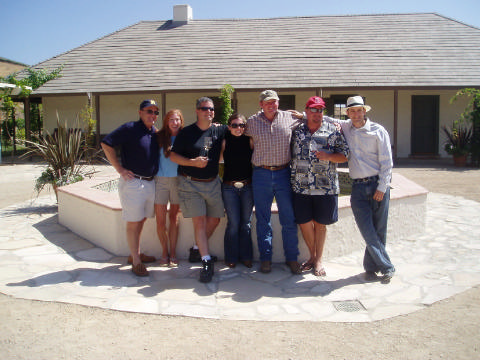 Bien Nacido (Spanish for “Born Well”) Vineyard of Rancho Tepusquet is one of the Central Coast’s premier sources for Chardonnay (over 300 acres) and Pinot Noir (over 250 acres). A number of other promising varietals are planted as well including Viognier, Pinot Blanc, Pinot Gris, Rousanne, Merlot, Barbera and Nebbiolo. The total acreage is fluid as old vines dating to the 1970s are removed and replanted. Maximum vineyard size is 800 acres. The vineyard is a few miles east of the town of Santa Maria and lies in a valley that is open to the Pacific Ocean to the west. There are regular summertime afternoon cool breezes from the ocean. Since the vineyard lies at 34 degrees latitude, it receives considerable intense sunlight from the directly overhead sun. All of the vineyard is allocated to small producers whose blocks are farmed according to their standards. The grape production is sold to customers by charging a flat rate for the block or rows, so the winemakers can crop their vines to the volume they prefer. Some Bien Nacido customers have sourced the same rows of grapes for over 20 years and designate their particular block on the bottle. The entire Bien Nacido Vineyard client list is on the website at www.biennacidovineyards.com.
2005 J. Wilkes Bien Nacido Vineyards Pinot Blanc 14.1% alc., 600 cases, $18. The grapes were machine harvested at night and pressed without de-stemming. Cold fermentation ensued and the wine was aged sur lies. · An excellent wine which is notable for its tropical flavors. Clean and crisp, this would make a perfect aperitif..
2005 Bernardus Bien Nacido Vineyards Pinot Noir 14.1% alc., 99 cases, $25. Sourced from two different blocks containing Pommard and 2A clone. Aged in 60% new oak. · Very nice garnet color. Heady aromatics of cherries, cola and spice. Nicely balanced with racy red fruits, supple tannins and palate-cleansing acidity. My favorite wine in this Pinot Noir lineup.
2004 Trou de Bonde Bien Nacido Vineyards Pinot Blanc 14.2% alc., 605 cases, $17. Cooperage included a mix of 70% stainless steel, 15% new French oak, and 15% neutral French oak. · A more Alsatian interpretation of Pinot Blanc compared to the California-styled Wilkes’ bottling. More body and viscosity, with notes of green apple and petrol. This wine paired perfectly with King Salmon, heirloom tomatoes and a fennel horseradish vinaigrette.
2004 Lane Tanner Bien Nacido Vineyards Pinot Noir 12,8%, $26. As you can tell by the alcohol level, Lane picks her grapes usually before anyone else, but an alcohol below 13% is a rarity, even for her. The wine is pure N Block (Martini clone planted in 1973 on its own rootstock). 35% new oak. · Lane warns that this wine tastes leaner than other years, but feels it will be long-lived. Her comment is right on as this wine is more austere and tart than the more showy 2005 release.
2004 Steele Bien Nacido Vineyards Block N Pinot Noir 13.5% alc., $26. · Noticeable chocolate in the nose, perfectly fine red fruit flavors, a soft texture and a good food wine. A little shallow on the back end.
2003 Stephen Ross Bien Nacido Vineyards Pinot Noir 13.6% alc., $40. · This wine is restrained in style with notable vegetal flavors on the finish.
2003 Foxen Bien Nacido Vineyards Block Eight Pinot Noir 14.6% alc., 425 cases, $48. This block was planted in 1996 with clones 2A, Sanford & Benedict (Mt. Eden), 113, 115, and Pommard. · A very darkly-colored wine of great intensity. Plenty of sweet, fresh, vivid fruit with power to thrill. A bit of heat peaks out on the finish.
2002 Nicolaysen Family Vineyards Bien Nacido Vineyards Pinot Noir 15.1% alc., 275 cases. This wine is from plantings over 30 years old in the “T” Block of Bien Nacido Vineyard. The unusual clone is 22 (from Beaujolais). The 2002 is the latest release. · Dark in color, rich, ripe, generous and jammy, with potent octane, this is not a wine for the faint of heart. Several tasters loved this wine which I thought smelled a lot better than it tasted.
I am certainly no expert on Syrah, but among the four that were presented, the 2003 Ojai Vineyard Bien Nacido Vineyards Syrah and the 2004 Ambullneo Santa Maria Howling Syrah (85% Bien Nacido Vineyards) were clearly my favorites. We finished off the evening with an outrageous dessert wine, the 2003 Sine Qua Non Mr. K The Nobleman Late-Harvest Bien Nacido Vineyards Chardonnay (12.3% alc., $100).
Small SipsThese are Pinot Noirs that I randomly tasted over the last several months
2005 Malm Cellars Sonoma County Pinot Noir 14.4% alc., 118 cases, $19. Highly-touted and a Los Angeles Times Wine of the Week. A reserve release has been highly recommended in the press as well. · Classy bottle with wax capsule which is unusual for wine in this price range. The wine shows an impressive core of plums, blackberries, cassis, and spice. The aromatics are wanting, but this is not a wine made to contemplate, but to suck down with a good hamburger.
2005 B. Kosuge Wines The Shop Carneros Pinot Noir 14.5% alc., $30. · The perfume of ripe cherries and vanilla with a hint of oak leads to a potpourri of plum and blackberry flavors. Nicely balanced. A calming drink that is easy to cozy up to.
2005 Paul Matthew Vineyards Ruxton Vineyard Russian River Valley Pinot Noir 13.9% alc., $30. Winemaker Mat Gustafson. · Macerated ripe strawberries and cherries, exotic woods and oak are featured in the aromas and flavors. Silky texture and admirable balance. At this point in its development, the oak trumps the fruit.
2005 Kanzler Vineyards Sonoma Coast Pinot Noir 14.9% alc. · Very deep ruby color. Bright plum and blackberries with herbal overtones are the theme. Silky in texture with a plush mouth feel and a tangy finish. A big tiger with a pussycat sensibility. A bigger style that I liked alot.
2004 Louis Guntrum Spätbergunder Trocken 13.0% alc. Imported by Broadbent Selections, Inc. San Francisco. · Medium-bodied with sour cherry and cranberry flavors. Unusual wood notes throughout (doubt French oak). Soft tannins and decent balance. A quaff.
2004 Au Bon Climat La Bauge Au-dessus Santa Maria Valley Pinot Noir 13.5% alc., $30. From the highest planting in the Bien Nacido Vineyard. · Intoxicating nose of fresh crushed cherries. Cherries and cranberry flavors are set off by herbal notes. The texture is soft. Nothing earthshaking, but perfectly fine.
2004 Au Bon Climat Le Bon Climat Santa Maria Valley Pinot Noir 13.5% alc., $35. From the Clendenen Le Bon Climat Vineyard. · Red fruits in the aromas are joined by significant oak. Cherry rhubarb flavors are underlain with earth and herbal touches. A decent Pinot Noir.
2003 Mueller Emily’s Cuvee Russian River Valley Pinot Noir 14.8% alc., $38. · A veritable cherries jubilee framed by heavy oak. For those with an oak fetish.
2003 Talisman Ted’s Vineyard Russian River Valley Pinot Noir 14.1% alc., 259 cases, · Light in color, this wine still delivers the goods with dark fruits and mushrooms in the nose and lovely cherry fruits on the mid-palate. Earthiness, vanilla and spice add charm. Brisk acidity and residual oak tannins on the finish indicate a need for further cellaring. A Pinot with a light touch that one could spend time with.
 2003 Miura Silacci Vineyard Monterey County Pinot Noir $54. Vinified by Byron Kosuge (formerly Saintsbury, now B. Kosuge Wines, Mirua, and Kinston Family in Chile). · The nose opens with air time to appealing berry, spice and oak aromas. Flavors of dark Pinot fruits have a rustic and earthy edge. A soft, elegant style with gossamer tannins. The nose trumps the flavors at this stage.
Wally’s Central Coast Wine & Food CelebrationThis 4th Annual event benefiting the Michael Bonaccorsi Scholarship Fund at the University of California Davis Department of Viticulture and Enology was held recently on Sunday, August 5. Jenne Lee Bonaccorsi, who is now making the wine for Bonaccorsi Wine Company, told me the event was a big success. The final tally is not in, but close to $50,000 was raised. 20% more people attended than last year, and another 100 walk-up people were turned away. The celebration was held outdoors in a big tent on a glorious Southern California day. 54 wineries were pouring and the food was outrageously good from restaurants like Spago Beverly Hills, Pizzeria Mozza, La Brea Bakery, Campanile, Lucques/A.O.C., Literati II, Sushi Roku, Hitching Post, Hungry Cat and more. A few Pinots stood out for me: 2005 Melville Terraces Pinot Noir, 2005 Ambullneo Rancho Ontiveros Pinot Noir, 2003 Calera Mt Harlen Mills Pinot Noir, 2005 Native 9 Santa Maria Pinot Noir, 2005 Paul Lato Solomon Hills “Suerte” Pinot Noir, 2005 Row Eleven Santa Maria Valley Pinot Noir, and the 2005 Tantara La Colline Arroyo Grande Pinot Noir. 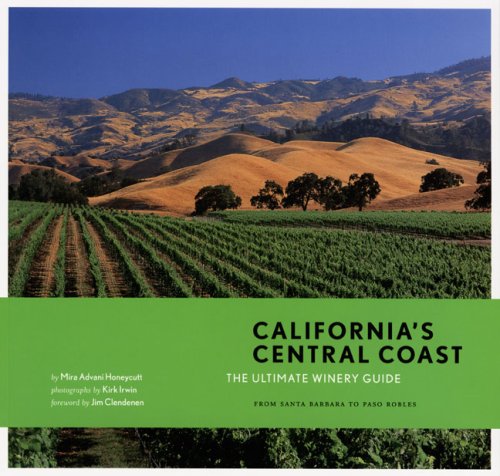
Sonoma County Grape CampBilled as the ultimate wine and food adventure, this “camp” is held September 24-26, 2007. Day One offers a welcoming dinner at Hoot Owl Vineyard in the Alexander Valley. Day Two campers harvest grapes and then visit Sonoma-Cutrer for a tasting of the just crushed grape juice with winemaker Terry Adams, followed by lunch. In the afternoon, there is a food and wine workshop at the Vintners Inn with Chef John Ash. In the evening, a paella feast and wine tasting party is held along the banks of the Russian River. Day Three begins with more vineyard harvesting and then off to Ferrari-Carano to blend wine with winemaker Aaron Piotter. Lunch follows at the winery. In the afternoon, travel to Redwood hill Farm for a cheese making tour and a session on wine and cheese pairing. Graduation follows in the afternoon. For information, visit the website at www.SonomaGrapeCamp.com. Cost is $1,500 per person per couple including two nights at the Vintners Inn. |